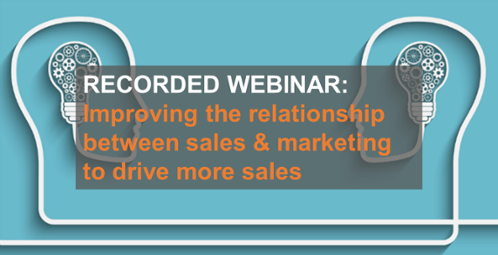
Times have changed. Today’s buyers are more empowered. Sales no longer controls the flow of information in the buying process - the buyer does. If buyers have a question about a product or service, they can just search online and receive information instantly, privately, and from a variety of sources.
This move from a sales cycle to a buying cycle changes the goals posts for both Sales and Marketing teams. It means that Marketing now have much more influence before Sales are engaged, and therefore seamless alignment between marketing and sales processes, no matter what size of organisation is absolutely vital.
According to the Aberdeen Group companies with good Sales & Marketing alignment experience a 32 % annual revenue growth compared to those that don't. And 38% of CMOs say that aligning and integrating Sales and Marketing is a top priority for 2015 (CMO Council).
Sales and marketing alignment helps Sales and Marketing work together to improve the all the processes for customer acquisition (lead generation, lead nurturing, lead qualification and sales closing).
So what are some of the key ingredients to breaking down the barriers between Sales and Marketing so that they are better aligned and can work together to close more leads?
1. AGREE BUYER PERSONAS
Part of the job of inbound marketers is to gain insight into the buyer’s need for information at every stage of the journey. To do this properly, you need to have your Buyer personas figured out. Buyer personas allow you to define exactly who you are trying to reach, what type of message you hope to send, and how you plan to send that message.
With your personas created, you can use the information you have collated to directly target your content to addressing the specific pains and needs that your ideal buyer faces in their business life. You can provide them with precisely the information they need so that they will perceive your business as the answer to all of their problems.
2. DEFINE THE STAGES IN THE FUNNEL
Sales and Marketing teams often have a very different picture of the funnel. They might disagree about the number of stages a lead passes through before becoming a customer – and they often use different terminology to describe those stages. To be effective, Sales and Marketing must have a unified picture of the funnel and standard definitions of each stage in the process.

Establishing what constitutes a Marketing Qualified Lead (MQL) is crucial as this is the hand over point between marketing and sales. Every company’s definition of an MQL will vary, but it should reflect a combination of traits and actions that indicate a lead is both a good fit for your company and ready to talk to a salesperson.
Marketing will then be able to pass over better qualified leads to sales for sales to engage with them with greater understanding of the specific requirements to close the sale.
3. REGULAR COMMUNICATION AND FEEDBACK
Without a regular communication, Sales and Marketing teams will never be fully aligned. Sales can help Marketing improve their lead generation and qualification process by showing the Marketing team which leads are higher quality (making it further along the sales process) and why.
If Sales doesn’t tell Marketing about unqualified leads that got passed as qualified, the same type of low quality leads will keep showing up at the top of the sales process. By having the two departments communicate on a regular basis with each other, you can improve sales outcomes by giving both Sales and Marketing a complete understanding of what’s working and what isn’t.
4. MEASUREMENT
Data is the crucial ingredient for maintaining sales and marketing alignment. You need data to monitor progress toward goals, analyse lead quality, and measure marketing ROI. Dashboard and reporting features of marketing automation systems provide better visibility and insight in to what is working in regards to your marketing and what isn’t and requires improvement. No more guess work - you are able to know exactly which blogs, emails, CTAs, social posts result in the most closed business.
But a word to the wise - marketing automation platforms are only as good as the information that you put into them. If unqualified leads are being passed to Sales automatically, it is up to Marketing to update these triggers to become more accurate. The objective of Marketing and Sales alignment is knowing when a process is working and when it isn’t, so you can keep improving your Sales and Marketing strategies.
Following these simple steps: developing your Buyer Personas, getting agreement on definitions of what constitutes an MQL, continual communication and feedback between the two departments and use of marketing automation systems for reporting and measurement will ultimately lead to both departments performing better, more efficiently and closing more sales.
Discover more about the benefits of Sales and Marketing alignment - Read More
.png?width=250&height=76&name=Intellegentia%20Logo%20(MAIN).png)
